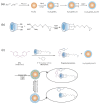Molecularly Imprinted Polymer Micro- and Nano-Particles. A review
- PMID: 33076552
- PMCID: PMC7587572
- DOI: 10.3390/molecules25204740
Molecularly Imprinted Polymer Micro- and Nano-Particles. A review
Abstract
In recent years, molecularly imprinted polymers (MIPs) have become an excellent solution to the selective and sensitive determination of target molecules in complex matrices where other similar and relative structural compounds could coexist. Although MIPs show the inherent properties of the polymers, including stability, robustness, and easy/cheap synthesis, some of their characteristics can be enhanced, or new functionalities can be obtained when nanoparticles are incorporated in their polymeric structure. The great variety of nanoparticles available significantly increase the possibility of finding the adequate design of nanostructured MIP for each analytical problem. Moreover, different structures (i.e., monolithic solids or MIPs micro/nanoparticles) can be produced depending on the used synthesis approach. This review aims to summarize and describe the most recent and innovative strategies since 2015, based on the combination of MIPs with nanoparticles. The role of the nanoparticles in the polymerization, as well as in the imprinting and adsorption efficiency, is also discussed through the review.
Keywords: hybrid sorbent; microextraction; molecularly imprinted polymer; monolith; nanomaterial; sensor.
Conflict of interest statement
The authors declare no conflict of interest. The funders had no role in the design of the study; in the collection, analyses, or interpretation of data; in the writing of the manuscript, or in the decision to publish the results.
Figures






References
-
- Liu Q., Wan J., Cao X. Synthesis of core-shell molecularly imprinted polymers (MIP) for spiramycin I and their application in MIP chromatography. Process. Biochem. 2018;70:168–178. doi: 10.1016/j.procbio.2018.04.001. - DOI
-
- Li G., Row K.H. Recent Applications of Molecularly Imprinted Polymers (MIPs) on Micro-extraction Techniques. Sep. Purif. Rev. 2017;47:1–18. doi: 10.1080/15422119.2017.1315823. - DOI
Publication types
MeSH terms
Substances
Grants and funding
LinkOut - more resources
Full Text Sources
Other Literature Sources

